Exploring Diamonds: From Carbon to Gemstone
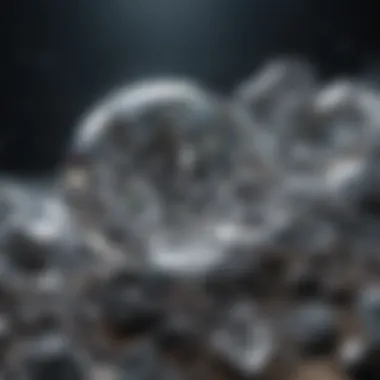
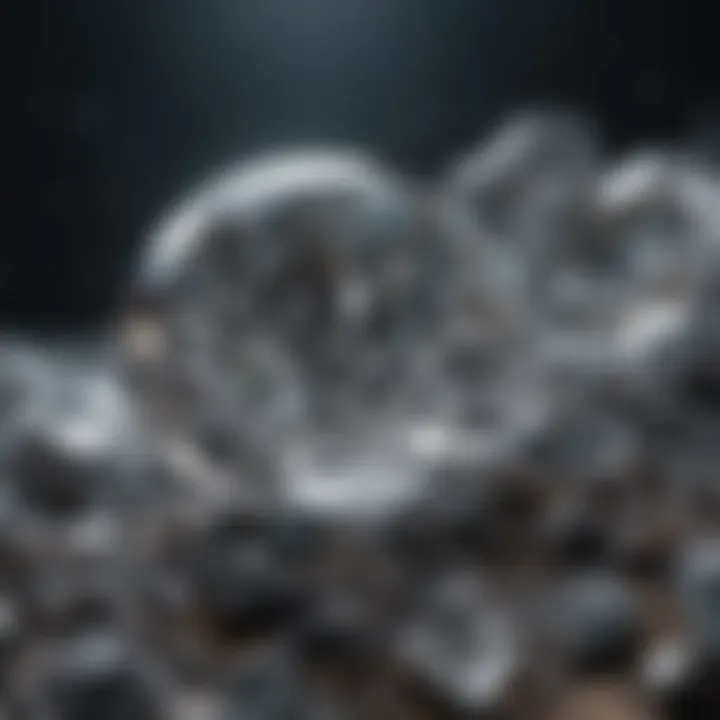
Intro
Diamonds have long captivated the human imagination, gleaming with a brilliance that transcends mere aesthetics. To many, they are the coveted symbols of love, prestige, and power. Yet, beneath their dazzling facade lies a tale of transformation that begins with a humble element: carbon. In their journey from carbon atoms to glittering gemstones, diamonds undergo profound geological and chemical changes that illustrate the beauty of nature's processes.
This article aims to create a vivid picture of diamonds, integrating their origins, structure, and the many varieties that exist in nature. Furthermore, it tackles the implications surrounding synthetic diamonds and ethical mining practices, fostering an insightful discussion pertinent to rock and fossil collectors. Engaging with the story of diamonds is not only about appreciating their beauty but also understanding their significance in Earth's history and human culture.
Prelude to Diamonds and Carbon
Diamonds, those sparkling gems coveted throughout history, are not merely accessories; they are symbols of status, love, and even geological marvels. Their birth is a tale woven from the most basic of elements: carbon. Understanding this relationship is essential for anyone diving into the depths of geology or gemology. In this section, we will lift the curtain on both diamonds and their carbonaceous origins.
The importance of comprehending how carbon transforms into diamonds resides not just in recognizing their beauty but also grasping their geological significance. Diamonds form under conditions that, to the untrained eye, may seem extraordinary and inaccessible. By delving into their basic composition, we uncover the intricacies of nature's synthesis process, which highlights the remarkable resilience of carbon arranged in a crystal lattice arrangement that gives diamonds their unparalleled hardness.
Additionally, understanding carbon's role is pivotal in grasping the broader environmental and ethical considerations surrounding diamond mining. As we engage with the Earth's lithosphere, we see how the elements we often take for granted have consequences beyond their aesthetic appeal.
"Every diamond is a story waiting to be told, from its carbon origins to its journey through time."
Whether you're a rock enthusiast or merely curious about the matter, this journey into diamonds and carbon will enlighten your perspective. Let’s dive deeper into the chemical make-up of these fascinating structures.
The Basic Composition of Diamonds
The composition of diamonds is deceptively simple. At its core, a diamond is essentially a crystalline form of carbon. What differentiates it from other carbon forms, like graphite or carbon soot, is the arrangement of those carbon atoms. In diamonds, each carbon atom is tetrahedrally bonded to four other carbon atoms, creating a repeating pattern that extends throughout the entire stone. This three-dimensional structure is what makes diamonds not only exceptionally hard but also brilliant when cut and polished.
Furthermore, the type of carbon that forms diamonds can originate from various sources, including organic material, but also from deep within the Earth’s mantle where the pressures and temperatures are intensely high. This formation process can take millions, even billions of years, giving rise to the cultural significance diamonds hold as symbols of eternity.
What is Carbon?
At its essence, carbon is one of the most prevalent elements in the universe, known for its unique ability to bond with a wide array of elements. This versatility is why carbon forms the foundation of all known life. But beyond that, it plays a pivotal role in geological processes.
Carbon exists in several allotropes, of which diamond is one, and graphite is another. The difference between these forms is primarily in how the carbon atoms are arranged. In graphite, carbon atoms form sheets that can slide over one another, making it slippery and conducive to lubrication. In contrast, diamond's lattice structure results in exceptional hardness and brilliance.
Understanding carbon's position in the periodic table provides valuable insights into its reactivity and utility in other domains, such as organic chemistry and materials science. Its presence is not only a boon for gem creation but also central to several geological and biological processes, knitting it into the fabric of life and the Earth itself.
Formation Process of Diamonds
Understanding the formation process of diamonds is crucial to grasping their allure and value in both natural and synthetic contexts. Diamonds, being one of the toughest materials known to man, do not just pop up out of thin air; there’s a complex series of events that unfold under very specific conditions. Comprehending these processes sheds light on why diamonds are so rare and prestigious. Additionally, for those in the field of geology and mineralogy, learning about these processes adds depth to the knowledge of Earth’s functionalities and the elements contained within.
Conditions Required for Diamond Formation
Temperature and Pressure Relations
When it comes to the formation of diamonds, the interplay between temperature and pressure is vital. Diamonds form at extreme conditions—generally, this means temperatures over 1,000 degrees Celsius and pressures that can exceed 725,000 pounds per square inch. The heat and pressure deep within the Earth create the environment necessary for carbon atoms to bond in a unique tetrahedral structure; this is what gives diamonds their exceptional hardness.
A particular characteristic of these conditions is that they are typically found about 100 miles beneath the surface of the Earth, in areas of the mantle. This depth is significant because it is where tectonic activities push carbon-rich materials into these extreme environments. The specific temperature and pressure conditions not only help in the formation of diamonds but also determine the quality and characteristics of the final product.
However, these extreme requirements make natural diamond formation a rare occurrence. Another noteworthy aspect is the challenge of replicating such conditions for synthetic diamonds, adding to the intrigue of their creation.
Role of Carbon Sources
It’s not just about extreme heat and pressure; the source of carbon plays a central role in creating diamonds. Primarily, diamonds are formed from carbon that was present in the Earth’s mantle, but they can also come from carbon-bearing minerals such as pyroxene. This variety in sources can lead to differences in diamond properties, notably in their imperfections and inclusions.
The primary characteristic here is that the carbon must exist in a pure form and be aged, providing a longer time frame for organized crystal structures to develop. This is important for understanding why some diamonds are more sought after than others—those formed from 'old' carbon sources tend to have a clearer and more remarkable structure.
Nevertheless, with carbon sourced from various geological stages, it presents unique features: for instance, diamonds formed from subducted oceanic plates can have different impurities than those formed from continental crust materials. This variability can also lead to differences in color and clarity, contributing to the complexities of diamond valuation.
Natural Geologic Processes


Volcanic Activities
Volcanic activities are a significant natural mechanism in the diamond formation saga. During explosive eruptions, materials from deep within the Earth, where diamonds might form, are brought closer to the surface. The various types of volcanic rocks, specifically kimberlite, are the prime hosts for diamonds.
The key trait of volcanic activities is that they create the pathways needed for diamonds to exit the depths of the Earth. These eruptions not only transport diamonds to the surface but can also affect their final appearance and characteristics. The sudden pressure and temperature changes during eruptions can alter diamonds, leading to unique traits.
Thus, volcanic eruptions serve as a natural conveyor belt, albeit an unpredictable one, carrying diamonds from their formation sites to the higher crustal levels where they can be mined.
Subduction Zones
Subduction zones offer another pathway for diamond formation, emphasizing the complexity of geological processes. These regions, where one tectonic plate moves under another, can serve as significant sites for the crystallization of diamonds. The pressure and temperature conditions can be quite favorable, making these zones another hotspot for diamond genesis.
A notable characteristic of subduction zones is that they often trap carbon deep within the Earth, creating ideal conditions for diamond formation.
The distinct advantage of this process is that it provides a steady supply of carbon to the mantle, leading to potential diamond deposits that can take thousands to millions of years to produce. However, these diamonds might be accompanied by other geological phenomena, such as metamorphic rocks, which can influence structures, and thus, this aspect is significant for rock and fossil collectors.
In summary, the formation of diamonds is a product of both well-defined geological conditions and an array of natural processes that intricately weave together.
Thus, understanding the formation process of diamonds provides a robust lens through which to examine the broader narrative of these gemstones, their mineral foundations, and their profound significance in human culture and the natural world.
Types of Diamonds
Understanding the various types of diamonds is key for anyone interested in the gem's formation, valuation, and significance. The distinction between natural diamonds mined from the earth and synthetic diamonds created in laboratories shapes much of the current conversations in both geological circles and consumer markets. Moreover, the allure of fancy color diamonds adds yet another layer of complexity to this topic, as their exquisite hues speak not only to artistic gravitas but also to rarity in nature. The choices between these diamond types are not merely aesthetic; they also involve ethical considerations, investment potentials, and personal significance.
Natural vs. Synthetic Diamonds
Understanding Natural Diamonds
Natural diamonds are formed deep within the Earth's mantle under extreme temperatures and pressures over the course of millions, sometimes billions, of years. This lengthy process imbues them with unique characteristics that are considered valuable in the gem world. One major advantage of natural diamonds is their high resale value, provided they are ethically sourced. Many collectors and investors value them for their rarity and the storied journey they undertake from formation to gemstone.
However, the disadvantage lies in the ethical concerns surrounding diamond mining practices. "Conflict diamonds," often associated with human rights abuses, continue to cast a shadow over the natural diamond industry. This backdrop contributes to the current discourse on the sustainability of diamond sourcing, highlighting the need for transparency in the supply chain.
Preface to Lab-Created Diamonds
Lab-created diamonds, also referred to as synthetic diamonds, are produced using innovative technologies that replicate the conditions under which natural diamonds form. The primary characteristic that sets these diamonds apart is their identical chemical composition to natural diamonds. This essentially means they share the same brilliance and physical qualities, and may even hold a similar aesthetic appeal.
A notable advantage of lab-created diamonds is their environmental impact; they typically require fewer resources and avoid many of the ethical dilemmas surrounding natural diamonds. The price of synthetic diamonds is generally more accessible, making them a popular choice for budget-conscious buyers. Yet, it's worth noting that their ongoing market value isn't always stable compared to natural counterparts, potentially leading to future concerns about resale.
Fancy Color Diamonds and Their Rarity
Varieties of Fancy Colors
Fancy color diamonds emerge in a kaleidoscope of hues—from deep blues and vivid pinks to lush greens. The unique characteristic of these diamonds is the intensity and saturation of their color, which determines their value. Such rarity makes them highly sought after in both the collectible and retail markets, eliciting a level of intrigue that surrounds their origin and growth.
The advantage of fancy color diamonds is their exceptional beauty and distinctive appeal, often standing out significantly in a jewelry collection. However, they can be substantially more expensive than colorless diamonds, depending on their quality and availability, putting them in a unique niche in the gem market.
Value Implications
The financial implications of owning fancy color diamonds go beyond their initial purchase price. The key characteristic here is the understanding that these gems often appreciate in value over time, particularly if they hold unique colors or characteristics. As more collectors seek out distinctive pieces, their demand could drive higher prices in the future.
A disadvantage in this context is market fluctuations. If a specific color becomes more sought after, it could shift the value dynamics. Collectors must stay informed about the trends in the fancy color diamond market to make prudent investment decisions.
Collecting diamonds is not just about beauty; it is about understanding the story behind each stone, its value, and its role in the broader context of geological and economic factors.
The Structure of Diamonds
Diamonds are not just prized for their sheer beauty and rarity, but also for their complex structure, which plays a pivotal role in their properties and applications. Understanding the structure of diamonds provides insights into why they are sought after across various fields, from the jewelry industry to industrial applications. The crystalline arrangement of carbon atoms is foundational to diamonds’ renowned hardness, making them symbols of strength and durability. Moreover, the intricate nature of their physical and optical properties adds to their allure and significance.
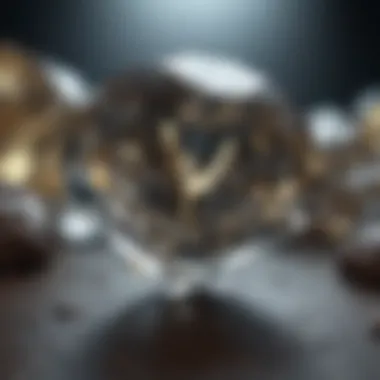
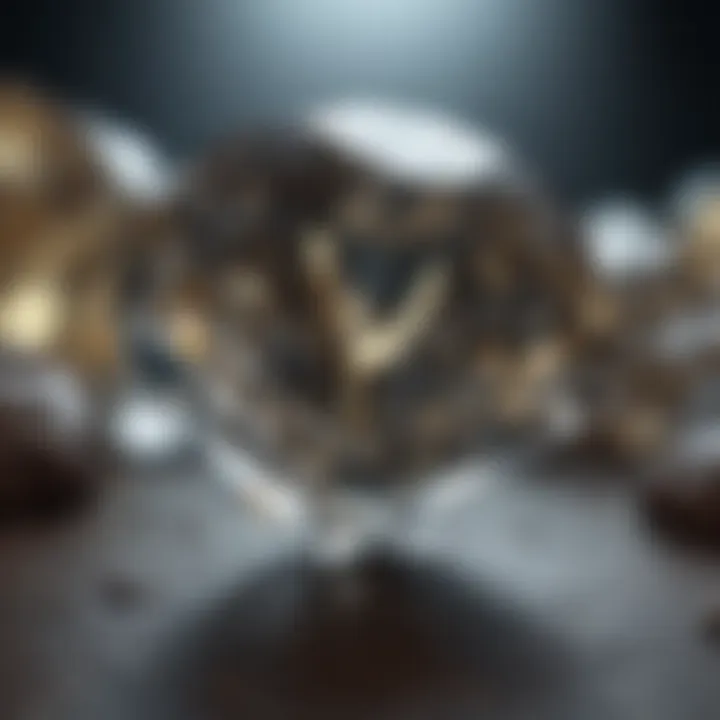
Crystalline Arrangement
The crystalline arrangement of diamonds is a fascinating topic. At the heart of every diamond lies a crystal lattice made entirely of carbon atoms. These atoms are arranged in a tetrahedral formation, where each carbon atom is bonded to four others via strong covalent bonds. This unique spatial configuration gives diamonds their characteristic hardness and strength, setting them apart from other minerals.
Moreover, this arrangement is not just about strength; it is also essential for creating the diamond's stunning visual properties. The symmetrical geometry allows light to pass through and reflect in ways that enhance sparkle and brilliance. Such physical characteristics are significant for gemologists and collectors alike.
The crystal structure defines what a diamond is—its beauty, its strength, and its utility. Understanding this helps us appreciate not just the gem but the science behind it.
Physical Properties of Diamonds
Diamonds exhibit several remarkable physical properties, primarily stemming from their crystalline structure. Two of the most notable attributes include hardness and optical clarity, both crucial elements when discussing diamonds.
Hardness and Durability
When it comes to hardness, diamonds are unsurpassed. They rank highest on the Mohs scale, which measures mineral hardness. This attribute is primarily due to the tight bonding between carbon atoms in the diamond's lattice. Such hardness makes diamonds ideal not just for jewelry, but also in industrial applications where cutting and grinding are necessary.
The hardness of diamonds offers a significant advantage in various sectors, including electronics, construction, and engineering, where precise cutting instruments are essential. However, despite their incredible toughness, diamonds are brittle and can be chipped if struck at certain angles. This feature becomes a crucial consideration for those in the diamond trade, as care must be taken during handling and setting.
Optical Properties
One cannot discuss diamonds without mentioning their striking optical properties. Diamonds are famous not only for their brilliance but also for their fire—the dispersion of light into various colors. This effect is enhanced by the crystal structure, which allows light to enter, reflect, and refract within the diamond. As a result, diamonds create a visual effect that is unique and captivating.
Their durability and optical excellence contribute significantly to their commercial value. Diamonds with superior optical properties can fetch premium prices. However, nuances in clarity, color, and cut can dramatically alter the perceptual performance of a diamond.
Cultural and Economic Significance of Diamonds
The cultural and economic significance of diamonds cannot be overstated. In many societies, diamonds have transcended their geological origins to embody status, power, and a sense of beauty that captivates the human experience. They are often seen as symbols of love and commitment, especially in the context of engagements and weddings. This has prompted a multitude of industries to flourish around these gemstones, elevating their economic value to astonishing heights.
Historical Perspectives on Diamonds
Cultural Symbols
Diamonds have long established themselves as cultural symbols across various civilizations. They are often associated with wealth, purity, and strength. In many traditions, a diamond symbolizes unbreakable bonds and eternal love. This cultural symbolism extends beyond romantic purposes; in some cultures, diamonds are believed to bring luck and protection. The significance that people place on diamonds, thus, reflects societal values around commitment and fidelity.
The primary characteristic of diamonds as cultural symbols is their perceived rarity and intrinsic worth. Cultures that prize these stones show a reverence for their beauty and qualities. For instance, in India, diamonds have been regarded as mystical and have often been linked to deities, adding layers of belief and tradition to their physical allure. However, while diamonds are desirable, their status can also lead to elitism, creating divides between those who can afford them and those who cannot.
Royal Connections
Royal connections to diamonds date back centuries, further embedding them in our cultural narrative. They have adorned crowns, scepters, and other regalia, signifying power and dominion. A notable example is the Koh-i-Noor diamond, famously passed through various royal hands from India to England. Its history encompasses tales of conquest and intrigue, enriching the diamond's reputation as a symbol of royal authority.
The royal connections add a layer of drama and allure to diamonds that can’t be overlooked. The key characteristic of these ties is the association with unapproachable wealth and historical significance. This draws a significant amount of public interest and drives market demand. However, it’s also a double-edged sword; while it bolsters the aura around diamonds, it can overshadow the darker illustrious legacy involving conflicts and exploitation surrounding diamond mining.
Modern Economic Impact
Market Analysis
The diamond market is a complex web that has evolved with changing consumer trends and technological advances. The demand for diamonds remains significant for both jewelry and industrial purposes. The market analysis indicates that while natural diamonds continue to hold value, the rise in synthetic alternatives has begun to influence prices and consumer preferences.
A critical aspect of market analysis is the fluctuation in diamond prices, which can be affected by geopolitical factors, supply chain dynamics, and consumer attitudes towards ethical sourcing. Understanding these trends helps collectors and investors navigate the market more effectively. For instance, the growing consciousness around the ethical implications of diamond mining has prompted a preference for lab-grown stones among some consumers, reshaping traditional market dynamics.
Investment Considerations
Investing in diamonds presents unique considerations that require careful thought. One might think of diamonds as a solid investment akin to stocks or bonds, but their value can be erratic. This makes investment considerations a vital part of understanding the diamond market.
One key aspect of investing in diamonds is liquidity. Unlike stocks, diamonds can be challenging to sell quickly and may demand a price well below the purchase value. Thus, potential investors should weigh these risks before committing substantial resources. Additionally, not all diamonds appreciate equally; understanding the grading system is essential for making informed purchases.
Ethical Considerations in Diamond Mining
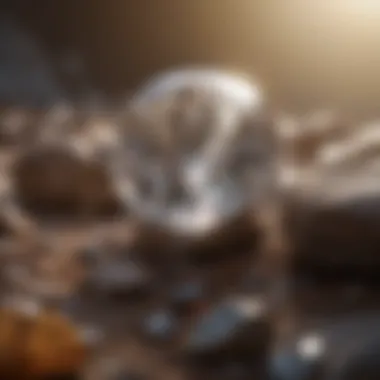

Understanding the ethical dimensions of diamond mining is vital in a world increasingly conscious about the impact of our choices. This topic sheds light on not just the practical implications, but also on deeper moral obligations associated with diamond sourcing. While diamonds evoke images of beauty and luxury, the conditions under which many of these stones are mined merit serious scrutiny. Being aware of these issues can empower consumers and collectors, ultimately steering the market towards more responsible practices.
Conflict Diamonds and Global Response
Conflict diamonds, often referred to as "blood diamonds", raise significant concerns. These stones are mined in war zones and sold to finance armed conflict against governments. The most notorious example is from Sierra Leone during the 1990s, where diamond revenues contributed to brutal civil wars.
Global responses have evolved, most notably with the establishment of the Kimberley Process Certification Scheme in 2003. This agreement aims to prevent the trade of conflict diamonds by requiring that diamonds are certified as conflict-free. Despite its intentions, the effectiveness of the Kimberly Process has been held under scrutiny. Some argue that it hasn’t been stringent enough, allowing conflict diamonds to seep into the market through loopholes.
Many organizations, such as Global Witness and Amnesty International, advocate for stricter enforcement and transparency in diamond sourcing. They emphasize that consumers hold the power; by choosing to buy from companies that adhere to ethical practices, the demand can push the industry towards more responsible mining methods.
"Purchasing ethically sourced diamonds is not merely a decision: it’s a commitment to sustainable practices and social responsibility in an industry rife with complexities."
Sustainable Practices in Mining
As concerns about the social and environmental impacts of diamond mining grow, sustainable practices are becoming increasingly important. Sustainable mining aims to mitigate the adverse effects by adopting environmentally friendly methods and ensuring fair labor practices.
Here are some strategies for sustainable diamond mining:
- Fair Trade Certification: Ensuring miners receive fair wages and work in safe conditions can fundamentally change lives.
- Environmental Management: Implementing practices that minimize habitat destruction and pollution during excavation.
- Community Engagement: Involving local communities in decision-making processes can foster better relationships and encourage investment in community welfare.
- Rehabilitation of Mining Sites: After mining operations cease, restoring the ecosystem to its original state or improving it can help restore biodiversity.
Incorporating these practices is not just beneficial for the environment and communities; it also caters to a discerning market. Consumers are increasingly seeking products that can assure them of ethical values, making the demand for sustainably sourced diamonds rise significantly. As collectors and enthusiasts, understanding these elements can enhance the appreciation of diamonds, aligning their allure with the broader positive impact on society and the planet.
Future of Diamond Production
The future of diamond production holds significant implications for both collectors and the broader industry. As technology continues to evolve, the landscape of diamond creation is experiencing marked changes that challenge traditional practices. Understanding these advancements can illuminate the shifting dynamics in both synthetic diamond technologies and the economic areas affected by these innovations. With greater efficiency and reduced environmental impact, the upcoming pathways in diamond production enhance the appeal of ownership in a material that has captivated humanity for centuries.
Advancements in Synthetic Diamond Technology
Synthetic diamond technology has made remarkable strides over the past few years. With methods such as High Pressure High Temperature (HPHT) and Chemical Vapor Deposition (CVD), the creation of diamonds that mirror their natural counterparts, both in appearance and physical properties, is now well-established. These processes allow for the production of diamonds that are virtually indistinguishable from mined ones, which shifts attitudes in the market.
- Quality Consistency: Synthetic diamonds exhibit less variability in color and clarity, making them appealing choices for those looking for flawless gems
- Lower Costs: Typically priced lower than natural diamonds, synthetic alternatives are catering to a more budget-conscious clientele without sacrificing quality.
- Wider Availability: Production can scale quickly, leading to a steady supply that meets demand more effectively than traditional mining.
Moreover, the environmental implications cannot be overstated. With fewer resources depleted and a lower carbon footprint, synthetic options align more closely with the ethical consumption expectations of today’s consumers.
Impact on Traditional Mining Industries
The rise of synthetic diamonds does not come without its repercussions for traditional diamond mining industries. As these lab-created alternatives gain wider acceptance, the economic landscape is shifting, prompting a reevaluation of what diamond mining means in the modern age.
- Market Competition: Natural mines face increased pressure as synthetic diamonds carve out a significant niche in the marketplace. Sales may see a downturn, leading to potential job loss and even mine closures in certain regions.
- Ethical Mining Practices: There’s an increasing demand for ethically sourced natural diamonds. Mining companies are feeling the heat to adopt transparent practices. Buyers are becoming more discerning, preferring diamonds that can guarantee conflict-free sourcing.
- Investment Shifts: Many investors are turning their attention to synthetic diamonds as a safer financial bet, which may lead to a diversification of assets that once were primarily focused on natural stones.
Ultimately, the face of diamond production is changing. The duality between natural and synthetic diamonds will become more pronounced as the technologies advance. Traditional mining industries will need to adapt and innovate if they wish to remain relevant in the evolving market landscape.
The continuing evolution in diamond production shapes not only the stones but also the stories they carry and the industries behind them.
Ending: The Lasting Allure of Diamonds
The brilliance of diamonds has captivated humanity for centuries, making them synonymous with beauty, prosperity, and elegance. In this article, we have traversed the multifaceted aspects of diamonds, focusing on their intimate relationship with carbon and the complex processes involved in their transformation from simple elemental carbon into the stunning gemstones we admire today.
Diamonds are not merely stones; they encapsulate a story of incredible change, both chemically and geologically. This metamorphosis, driven by stringent conditions of temperature and pressure deep within the Earth, highlights the remarkable journey that carbon undertakes. One can't help but appreciate the intricate dance of elements that occurs beneath our feet, where mundane carbon atoms yield to become the exquisite diamonds that grace rings, necklaces, and a plethora of other adornments.
When we consider the significance of diamonds, it isn’t just about their aesthetic appeal. Their value is rooted in cultural meanings and historical connections, as well as contemporary implications surrounding ethical mining practices and synthetic production. The rise of lab-created diamonds is reshaping perceptions, challenging the traditional narratives we hold dear about these precious gems.
Ultimately, the allure of diamonds lies in their dual nature as symbols of love and commitment while also representing the delicate balance between nature and human desire. As we reflect on the intertwined fate of diamonds and carbon, we are reminded that both hold a valuable place in our natural world, embracing a rich history that impacts our lives today.
"Diamonds are a girl's best friend," but perhaps they are also more than that, symbolizing an intersection of beauty, science, and responsibility.
Final Thoughts on Diamonds and Carbon
In wrapping up our exploration, it is clear that the relationship between diamonds and carbon extends far beyond mere physicality. Understanding this connection provides a lens through which we can view the ethical, cultural, and economic implications of diamond production. As rock and fossil collectors, it's worth noting that each diamond carries within it a profound narrative of transformation and resilience, echoing the very processes that shape our Earth.
To delve deeper into this subject, consider exploring resources that document the history and science behind diamonds, such as Wikipedia or Britannica. And for lively discussions on diamonds and related topics, forums like Reddit and social platforms like Facebook can be great places to connect with fellow enthusiasts.
As we continue to cherish these glittering gems, let us also be mindful of the stories they tell and the evolution that made them possible.



